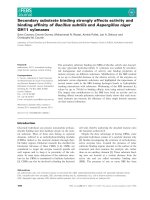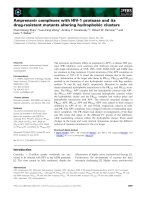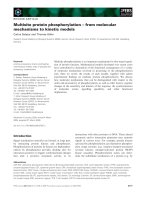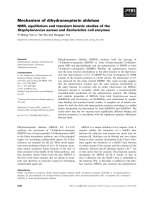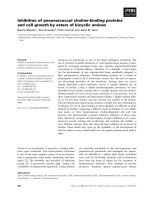Tài liệu Báo cáo khoa học: "Bilingual Terminology Acquisition from Comparable Corpora and Phrasal Translation to Cross-Language Information Retrieval" pptx
Bạn đang xem bản rút gọn của tài liệu. Xem và tải ngay bản đầy đủ của tài liệu tại đây (60.99 KB, 4 trang )
Bilingual Terminology Acquisition from Comparable Corpora and Phrasal
Translation to Cross-Language Information Retrieval
Fatiha Sadat
Nara Institute of Science and Technology
Nara, 630-0101, Japan
{fatia-s, yosikawa, uemura}@is.aist-nara.ac.jp
Masatoshi Yoshikawa
Nagoya University
Nagoya, 464-8601, Japan
Shunsuke Uemura
Nara Institute of Science and Technology
Nara, 630-0101, Japan
Abstract
The present paper will seek to present
an approach to bilingual lexicon extrac-
tion from non-aligned comparable cor-
pora, phrasal translation as well as evalua-
tions on Cross-Language Information Re-
trieval. A two-stages translation model
is proposed for the acquisition of bilin-
gual terminology from comparable cor-
pora, disambiguation and selection of best
translation alternatives according to their
linguistics-based knowledge. Different re-
scoring techniques are proposed and eval-
uated in order to select best phrasal trans-
lation alternatives. Results demonstrate
that the proposed translation model yields
better translations and retrieval effective-
ness could be achieved across Japanese-
English language pair.
1 Introduction
Although, corpora have been an object of study of
some decades, recent years saw an increased inter-
est in their use and construction. With this increased
interest and awareness has come an expansion in the
application to knowledge acquisition, such as bilin-
gual terminology. In addition, non-aligned com-
parable corpora have been given a special inter-
est in bilingual terminology acquisition and lexical
resources enrichment (Dejean et al., 2002; Fung,
2000; Koehn and Knight, 2002; Rapp, 1999).
This paper presents a novel approach to bilin-
gual terminology acquisition and disambiguation
from scarce resources such as comparable corpora,
phrasal translation through re-scoring techniques as
well as evaluations on Cross-Language Information
Retrieval (CLIR). CLIR consists of retrieving docu-
ments written in one language using queries written
in another language. An application is completed on
a large-scale test collection, NTCIR for Japanese-
English language pair.
2 The Proposed Translation Model in
CLIR
Figure 1 shows the overall design of the proposed
translation model in CLIR consisting of three main
parts as follows:
- Bilingual terminology acquisition from
bi-directional comparable corpora, completed
through a two-stages term-by-term translation
model.
- Linguistic-based pruning, which is applied on
the extracted translation alternatives in order to filter
and detect terms and their translations that are mor-
phologically close enough, i.e., with close or similar
part-of-speech tags.
- Phrasal translation, completed on the source
query after re-scoring the translation alternatives re-
lated to each source query term. The proposed re-
scoring techniques are based on the World Wide
Web (WWW), a large-scale test collection such as
NTCIR, the comparable corpora or a possible inter-
action with the user, among others.
Finally, a linear combination to bilingual dictio-
naries, bilingual thesauri and transliteration for the
special phonetic alphabet of foreign words and loan-
words, would be possible depending on the cost and
availability of linguistic resources.
2.1 Two-stages Comparable Corpora-based
Approach
The proposed two-stages approach on bilingual ter-
minology acquisition and disambiguation from com-
parable corpora (Sadat et al., 2003) is described as
follows:
- Bilingual terminology acquisition from source
language to target language to yield a first translation
model, represented by similarity vectors SIM
S→T
.
- Bilingual terminology acquisition from target
language to source language to yield a second
translation model, represented by similarity vectors
SIM
T →S
.
- Merge the first and second models to yield a two-
stages translation model, based on bi-directional
comparable corpora and represented by similarity
vectors SIM
(S↔T
.
We follow strategies of previous researches (De-
jean et al., 2002; Fung, 2000; Rapp, 1999) for the
first and second models and propose a merging and
disambiguation process for the two-stages transla-
tion model. Therefore, context vectors of each term
in source and target languages are constructed fol-
lowing a statistics-based metric. Next, context vec-
tors related to source words are translated using a
preliminary bilingual seed lexicon. Similarity vec-
tors SIM
S→T
and SIM
T →S
related to the first and
second models respectively, are constructed for each
pair of source term and target translation using the
cosine metric.
The merging process will keep common pairs of
source term and target translation (s,t) which appear
in SIM
S→T
as (s,t) but also in SIM
T →S
as (t,s),
to result in combined similarity vectors SIM
S↔T
for each pair (s,t).The product of similarity values in
vectors SIM
S→T
and SIM(
T →S
will yield similar-
ity values in SIM
S↔T
for each pair (s,t) of source
term and target translation.
2.2 Linguistics-based Pruning
Morphological knowledge such as Part-of-Speech
(POS), context of terms extracted from thesauri
could be valuable to filter and prune the extracted
translation candidates. POS tags are assigned to
each source term (Japanese) via morphological anal-
ysis.
Bilingual Seed
Lexicon
Linguistic-based Pruning
(Filtering based on Morphological knowledge of source
terms and translation alternatives)
Phrasal Translation
(Re-scoring the translation alternatives)
Bilingual Terminology
Extraction
Japanese →
→→
→ English
Merging & Disambiguation
Japanese ↔
↔↔
↔ English
Translation Candidates
Disambiguation
Phrasal Translation Candidates
Bilingual Terminology Acquisition
(Two-stages Comparable Corpora-based Model)
Linguistic-
based Pruning
Phrasal Translation
/ Selection
Japanese
Doc.
Content words (nouns, verbs, adjectives, adverbs, foreign words)
Bilingual Terminology
Extraction
English →
→→
→ Japanese
Japanese
Morphological
Analyzer
English
Morphological
Analyzer
Filtered Translation Candidates
Comparable Corpora
(Japanese-English)
English
Doc.
Linguistic Preprocessing
WWW
NTCIR
Test
Collection
Comparable
Corpora
Morphological
Analysis
Interactive
Mode
Figure 1: The Overall Design of the Proposed Model
for Bilingual Terminology Acquisition and Phrasal
Translation in CLIR
As well, a target language morphological anal-
ysis will assign POS tags to the translation candi-
dates. We restricted the pruning technique to nouns,
verbs, adjectives and adverbs, although other POS
tags could be treated in a similar way. For Japanese-
English pair of languages, Japanese nouns and verbs
are compared to English nouns and verbs, respec-
tively. Japanese adverbs and adjectives are com-
pared to English adverbs and adjectives, because of
the close relationship between adverbs and adjec-
tives in Japanese (Sadat et al., 2003).
Finally, the generated translation alternatives are
sorted in decreasing order by similarity values and
rank counts are assigned in increasing order. A fixed
number of top-ranked translation alternatives are se-
lected and misleading candidates are discarded.
2.3 Phrasal Translation
Query translation ambiguity can be drastically mit-
igated by considering the query as a phrase and re-
stricting the single term translation to those candi-
dates that were selected by the proposed combined
statistics-based and linguistics-based approach (Sa-
dat et al., 2003). Therefore, after generating a
ranked list of translation candidates for each source
term, re-scoring techniques are proposed to estimate
the coherence of the translated query and decide the
best phrasal translation.
Assume a source query Q having n terms {s
1
s
n
}. Phrasal translation of the source query Q
is completed according to the selected top-ranked
translation alternatives for each source term s
i
and
a re-scoring factor RF
k
, as follows:
Q
phras
=
k=1 thres
[Q
k
(s
1
s
n
)×RF
k
(t
1
t
n
; s
1
s
n
)]
Where, Q
k
(s
1
s
n
) represents the phrasal translation
candidate associated to rank k. The re-scoring factor
RF
k
(t
1
t
n
; s
1
s
n
) is estimated using one of the re-
scoring techniques, described below.
Re-scoring through the WWW
The WWW can be considered as an exemplar lin-
guistic resource for decision-making (Grefenstette,
1999). In the present study, the WWW is exploited
in order to re-score the set of translation candidates
related to the source terms.
Sequences of all possible combinations are con-
structed between elements of sets of highly ranked
translation alternatives. Each sequence is sent to a
popular Web portal (here, Google) to discover how
often the combination of translation alternatives ap-
pears. Number of retrieved WWW pages in which
the translated sequence occurred is used to represent
the re-scoring factor RF for each sequence of trans-
lation candidates. Phrasal translation candidates are
sorted in decreasing order by re-scoring factors RF .
Finally, a number (thres) of highly ranked phrasal
translation sequences is selected and collated into
the final phrasal translation.
Re-scoring through a Test Collection
Large-scale test collections could be used to re-
score the translation alternatives and complete a
phrasal translation. We follow the same steps as the
WWW-based technique, replacing the WWW by a
test collection and a retrieval system to index docu-
ments of the test collection.
NTCIR test collection (Kando, 2001) could be a a
good alternative for Japanese-English language pair,
especially if involving the comparable corpora.
Re-scoring through the Comparable Corpora
Comparable corpora could be considered for the
disambiguation of translation alternatives and thus
selection of best phrasal translations (Sadat et al.,
2002). Our proposed algorithm to estimate the re-
scoring factor RF , relies on the source and tar-
get language parts of the comparable corpora us-
ing statistics-based measures. Co-occurrence ten-
dencies are estimated for each pair of source terms
using the source language text and each pair of trans-
lation alternatives using the target language text.
Re-scoring through an Interactive Mode
An interactive mode (Ogden and Davis, 2000)
could help solve the problem of phrasal translation.
The interactive environment setting should optimize
the phrasal translation, select best phrasal transla-
tion alternatives and facilitate the information access
across languages. For instance, the user can access a
list of all possible phrases ranked in a form of hier-
archy on the basis of word ranks associated to each
translation alternative. Selection of a phrase will
modify the ranked list of phrases and will provide
an access to documents related to the phrase.
3 Experiments and Evaluations in CLIR
Experiments have been carried out to measure the
improvement of our proposal on bilingual Japanese-
English tasks in CLIR, i.e. Japanese queries to re-
trieve English documents. Collections of news ar-
ticles from Mainichi Newspapers (1998-1999) for
Japanese and Mainichi Daily News (1998-1999) for
English were considered as comparable corpora. We
have also considered documents of NTCIR-2 test
collection as comparable corpora in order to cope
with special features of the test collection during
evaluations. NTCIR-2 (Kando, 2001) test collec-
tion was used to evaluate the proposed strategies in
CLIR. SMARTinformation retrieval system (Salton,
1971), which is based on vector space model, was
used to retrieve English documents.
Thus, Content words (nouns, verbs, adjectives,
adverbs) were extracted from English and Japanese
texts. Morphological analyzers, ChaSen version
2.2.9 (Matsumoto and al., 1997) for texts in
Japanese and OAK2 (Sekine, 2001) for texts in En-
glish were used in linguistic pre-processing. EDR
(EDR, 1996) was used to translate context vectors
of source and target languages.
First experiments were conducted on the several
combinations of weighting parameters and schemes
of SMARTretrieval system for documents terms and
query terms. The best performance was realized by
ATN.NTC combined weighting scheme.
The proposed two-stages model using comparable
corpora showed a better improvement in terms of av-
erage precision compared to the simple model (one-
stage comparable corpora-based translation) with
+27.1% and a difference of -32.87% in terms of av-
erage precision of the monolingual retrieval. Com-
bination to linguistics-based pruning showed a bet-
ter performance in terms of average precision with
+41.7% and +11.5% compared to the simple compa-
rable corpora-based model and the two-stages com-
parable corpora-based model, respectively.
Applying re-scoring techniques to phrasal transla-
tion yields significantly better results with 10.35%,
8.27% and 3.08% for the WWW-based, the NTCIR-
based and comparable corpora-based techniques, re-
spectively compared to the hybrid two-stages com-
parable corpora and linguistics-based pruning.
The proposed approach based on bi-directional
comparable corpora largely affected the translation
because related words could be added as translation
alternatives or expansion terms. Effects of extracting
bilingual terminology from bi-directional compara-
ble corpora, pruning using linguistics-based knowl-
edge and re-scoring using different phrasal trans-
lation techniques were positive on query transla-
tion/expansion and thus document retrieval.
4 Conclusion
We investigated the approach of extracting bilin-
gual terminology from comparable corpora in or-
der to enrich existing bilingual lexicons and en-
hance CLIR. We proposed a two-stages translation
model involving extraction and disambiguation of
the translation alternatives. Linguistics-based prun-
ing was highly effective in CLIR. Most of the se-
lected terms can be considered as translation can-
didates or expansion terms. Exploiting different
phrasal translation techniques revealed to be effec-
tive in CLIR. Although we conducted experiments
and evaluations on Japanese-English language pair,
the proposed translation model is common across
different languages.
Ongoing research is focused on the integration of
other linguistics-based techniques and combination
to transliteration for katakana, the special phonetic
alphabet to Japanese language.
References
H. Dejean, E. Gaussier and F. Sadat. 2002. An Approach
based on Multilingual Thesauri and Model Combina-
tion for Bilingual Lexicon Extraction. In Proc. COL-
ING 2002, Taipei, Taiwan.
EDR. 1996. Japan Electronic Dictionary Research Insti-
tute, Ltd. EDR electronic dictionary version 1.5 EDR.
Technical guide. Technical report TR2-007.
P. Fung. 2000. A Statistical View of Bilingual Lexi-
con Extraction: From Parallel Corpora to Non-Parallel
Corpora. In Jean Veronis, Ed. Parallel Text Process-
ing.
G. Grefenstette. 1999. The WWW as a Resource for
Example-based MT Tasks. In ASLIB’99 Translating
and the Computer 21.
N. Kando. 2001. Overview of the SecondNTCIR Work-
shop. In Proc. Second NTCIR Workshop on Research
in Chinese and Japanese Text Retrieval and Text Sum-
marization.
P. Koehn and K. Knight. 2002. Learning a Translation
Lexicon from Monolingual Corpora. In Proc. ACL-02
Workshop on Unsupervised Lexical Acquisition.
Y. Matsumoto, A. Kitauchi, T. Yamashita, O. Imaichi and
T. Imamura. 1997. Japanese morphological analysis
system ChaSen manual. Technical Report NAIST-IS-
TR97007.
W. C. Ogden and M. W. Davis. 2000. Improving Cross-
Language Text Retrieval with Human Interactions. In
Proc. 33rd Hawaii International Conference on Sys-
tem Sciences.
R. Rapp. 1999. Automatic Identification of Word Trans-
lations from Unrelated English and German Corpora.
In Proc. European Association for Computational Lin-
guistics EACL’99.
F. Sadat, A. Maeda, M. Yoshikawa and S. Uemura.
2002. Exploiting and Combining Multiple Resources
for Query Expansion in Cross-Language Information
Retrieval. IPSJ Transactions of Databases, TOD 15,
43(SIG 9):39–54.
F. Sadat, M. Yoshikawa and S. Uemura. 2003. Learn-
ing Bilingual Translations from Comparable Corpora
to Cross-Language Information Retrieval: Hybrid
Statistics-based and Linguistics-based Approach. In
Proc. IRAL 2003, Sapporo, Japan.
G. Salton. 1971. The SMART Retrieval System, Experi-
ments in Automatic Documents Processing. Prentice-
Hall, Inc., Englewood Cliffs, NJ.
G. Salton and J. McGill. 1983. Introduction to Modern
Information Retrieval. New York, Mc Graw-Hill.
S. Sekine. 2001. OAK System-Manual. New York Uni-
versity.
